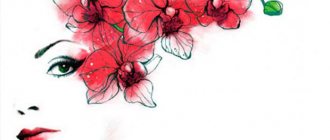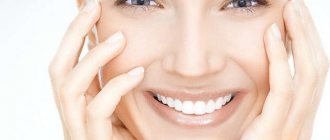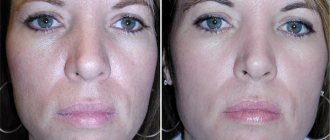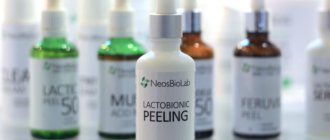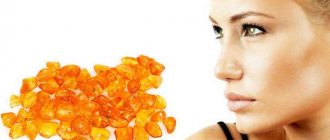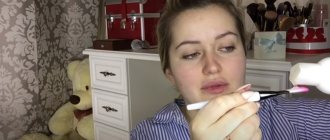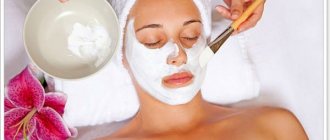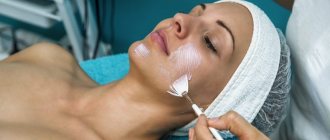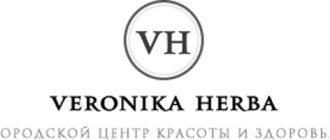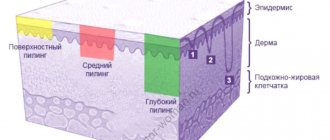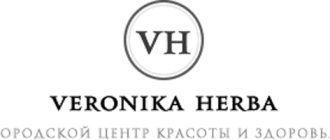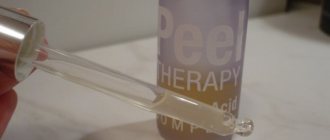Procedure Overview
Peeling with lactic acid has a gentle effect and does not injure the epidermis. After it, the skin becomes soft, elastic and elastic.
It is recommended to almost all patients, because... It is suitable even for sensitive, dry, problematic skin.
Age also does not matter - the procedure is permitted for those 18 years of age and older.
Efficiency
Lactic acid belongs to the class of fruit acids and is the result of the oxygen-free breakdown of glucose.
It is for this reason that peeling does not cause hypersensitivity. The molecules of the substance are small in size, so they settle on the surface of the epithelium and do not penetrate the dermis.
Buyanov Sergey Yurievich (Expert Doctor):
Every person has an idea about lactic acid. On the one hand: this is kefir and yogurt. On the other hand, there is pain in mice after intense exercise. In relation to external procedures, this is softening and moisturizing.
Under the influence of the drug, a whole cascade of chemical reactions is realized, as a result of which the skin whitens, the stratum corneum peels off, and the severity of signs of aging decreases.
With regular peeling, you can achieve many positive results:
- tissue moisture;
- natural glow;
- smooth facial relief;
- elimination of acne, pimples;
- even out complexion;
- relieving inflammation.
In addition, the work of the sebaceous glands decreases, which reduces the production of secretions, eliminates oily shine and clogged pores.
When does a side effect occur?
When used correctly, peeling based on lactic acid does not cause negative reactions. Sometimes after a cleaning session you may experience:
- slight peeling of the skin;
- moderate redness of the treated areas;
- feeling of heat, tingling or tingling.
Such problems are often solved by applying soothing compounds to the skin - Panthenol, shea butter. If burns occur, you will need to consult a specialist to prescribe special regenerating drugs.
Advantages and disadvantages
Like any other cosmetic procedure, milk peeling has its positive and negative sides. Details are described in the table.
| pros | Minuses |
|
|
Advantages and disadvantages
Milk peeling for the face has the following positive characteristics:
- the mask is suitable for any skin type, including sensitive and already damaged types;
- There is no noticeable peeling after the procedure, so recovery does not take much time;
- milk peeling at home or in a salon does not require preliminary preparation;
- During the procedure, significant hydration of the skin occurs - this is a very positive fact, unlike other types of peeling;
- also, unlike other varieties, the use of lactic acid is allowed in the summer;
- there is no need to use auxiliary products after the procedure;
- Can be used on dark skin.
Among the negative aspects, only low effectiveness for treating mature skin stands out - milk peeling for the face will not get rid of age-related wrinkles or deep flaws. Therefore, it is not recommended for women over 40 years old, with the exception of shallow “damages” to the facial skin.
Popular brands
At the moment, a huge number of peelings with lactic acid have been developed from different manufacturers. Below are the most popular ones.
- Peeling “milk mousse”, Premium . Created on the basis of lactic and other fruit acids, glycerin. The volume is 150 ml, the price is from 1100 rubles per tube. Suitable for both oily and dry skin.
- Mesopharm Professional Fresh: Lactic Peel (Milk peeling gel) . Refers to professional cosmetics, used in beauty salons, since the acid concentration is 20%. It is expensive, for 30 ml the buyer pays about 2500-3000 rubles. Country of origin: Russia.
- Dr.Jart Dermaclear Micro Milk Peel . A two-phase milk exfoliant provides high-quality and quick cleansing. The main component is supplemented with mineral water, panthenol and coconut milk. Volume – 100 ml, price – 2000 rubles.
- Milk peeling Lactipeel 80 % Two active ingredients: lactic acid 80% and dimethylaminoethanol 11%. In terms of indications for use, it is not much different from its analogues; it has a more aggressive effect on the skin. Cost - about 3000 rubles per 100 ml. Produced in Spain.
What's included
The main component is lactic (lactic) acid, which provides a complex effect:
- reduces the thickness of the stratum corneum;
- dissolves and removes contaminants;
- relieves the inflammatory process;
- removes age spots;
- whitens skin;
- stimulates regeneration processes.
Lactic acid promotes more active production of hyaluron, which deeply moisturizes the epidermis. It also strengthens the epidermal barrier, increases the skin's resistance to negative factors, and acts as an antiseptic.
The concentration of lactic acid in milk peeling varies from 10 to 50%. There are facial formulations with a higher content of this substance that have particularly active properties.
Peeling
Includes three main stages: pre-peeling care, self-cleaning and post-peeling care. On average, the entire session lasts 30-40 minutes and includes the following procedure:
- Pre-peeling care . For 10-14 days, doctors recommend refraining from going to the beach or solarium. For a week, you can use products that contain lactic acid in a minimum concentration. This way you can get your skin used to it and avoid an allergic reaction.
- Removing makeup and impurities . Apply a professional solution (tonic, lotion, milk) to a cotton pad and rub it over the surface of the skin with gentle movements.
- Toning . It involves degreasing the fabric with a composition based on fruit acids. The result of further manipulations depends on this stage.
- Peeling . A gel or cream with a low pH is evenly distributed onto the face with a fan brush or other similar tool, leaving the areas around the eyes and lips untouched. Sometimes the composition is applied in two layers with a break of 5-10 minutes.
- Neutralization . The remnants of the peeling are washed off with plain water to saturate the tissue with liquid and avoid irritation of the treated area.
At the end of the procedure, a nourishing, soothing cream or mousse is applied and recommendations for subsequent skin care are given.
How does milk peeling work?
After a course of using a cleansing product, the overall condition of the skin can be significantly improved. It helps to brighten and refresh the epidermis, restores its natural color, and improves tone. Using a drug with lactic acid helps to improve problematic skin, eliminates oily shine, and effectively fights blackheads, acne, acne and post-acne.
An important advantage of milk peeling is its versatility and safety. Cleaning does not cause dangerous consequences, so it can be used at any time of the year (including summer). It can also be performed on different parts of the body - on the neck, décolleté, and arms.
The procedure has a moderate rejuvenating effect and helps fight the first signs of skin aging. Facial peeling with lactic acid is gentle on the skin and can be used in sensitive areas, including the area around the eyes.
The method is not intended to eliminate deep age-related folds. That is why cosmetologists recommend it to women under 30–35 years old.
Aftercare
When the sun is active, before going outside, it is better to apply a cream filter (labeled SPF) to protect your face from the aggressive effects of ultraviolet radiation.
The use of other cosmetic products, including decorative cosmetics, must be discussed individually.
For the first two weeks after cleansing, you should not visit the sauna, bathhouse, solarium, or swimming pool. The use of masks with aggressive components or abrasive particles is strictly prohibited. Frequently touching your face with your hands is also not recommended, as you can get infected.
Buyanov Sergey Yurievich (Expert Doctor):
Restrictions after procedures are much softer than after peeling with more aggressive substances. This is due to the fact that virtually no traces of lactic acid remain inside the skin, therefore, reactions with external irritants are eliminated.
The best peelings with lactic acid
The list of quality products that have received positive reviews from cosmetologists includes:
- GIGI. Israeli preparations containing glycolic and lactic acids, a peptide complex. The products help effectively fight the first signs of aging. You can buy peeling in the form of a cream or liquid substance at a price of 3,000 rubles;
- Arabia. The product from a Russian manufacturer contains 10% lactic acid. Lightweight peeling "Arabia" well heals young problem skin. The product is applied to the face for only 3-5 minutes, after which neutralization is not required;
- Christina. Milk-glycol peeling, additionally enriched with essential oils and plant extracts, is produced in Israel. The drug in the form of a lotion has a pronounced regenerating and rejuvenating effect. The composition is safe and suitable for home use;
- "Belita". Budget Belarusian products are a universal option. A product with a lactic acid concentration of 30% is used in a salon or at home. The substance is sold in 250 ml bottles and 7 ml disposable sachets;
- "Tiande." Milk peeling is used for thorough cleansing of the face and various parts of the body (décolleté, hands). The drug is often chosen by professional cosmetologists. It is also suitable for regular home use;
- "Mediderma". Mediderma peels are produced in Spain. The product is intended for use in the salon. It is mainly indicated to combat the first signs of aging, dry skin;
- "Compliment". The product has a gel form and is one of the safest. The drug has a gentle effect on the epidermis and does not require the use of a neutralizer. Its cost is considered to be as affordable as possible;
- peeling with DMAE. Helps resist premature aging, reduces the depth of facial and age-related folds, and has a brightening and tightening effect. Its cost is about 2400 rubles.
The current price of a salon milk peeling procedure ranges from 1,000 to 4,000 rubles. After the sessions, you will need to purchase special care products for the treated skin. This at least doubles the overall cost of the professional service.
Precautionary measures
If peeling with lactic acid is performed for the first time, it is better to do a test to identify hidden hypersensitivity.
To do this, you need to drop a cosmetic product onto the inside of your forearm, distribute it evenly and wait 10-15 minutes.
If severe redness, itching, rash or swelling occurs, this composition is contraindicated for the patient.
Side effects
Despite the safety of the procedure, the development of undesirable effects cannot be ruled out. The list looks like this:
- severe burning sensation;
- chemical burn;
- allergies in the form of tissue hyperemia, itching, rash, swelling;
- inflammation due to secondary infection;
- pronounced peeling.
To avoid consequences, you need to contact a qualified specialist who takes into account all the rules and nuances of cleansing.
Contraindications
In some conditions, manipulation is strictly prohibited. The list of contraindications includes:
- increase in body temperature;
- growth of malignant neoplasm;
- development of type 1 or type 2 diabetes mellitus;
- violation of the integrity of the skin in the form of a wound, burn, cracks, abrasions;
- exacerbation of chronic non-infectious pathologies;
- spread of pathogenic microflora, formation of pustules;
- active form of herpes;
- pregnancy and lactation period.
Doctors advise against the procedure if hair removal has recently been performed or the patient is being treated with antibacterial drugs.
Who is contraindicated for milk peeling?
Some diseases are contraindications for cleaning:
- diabetes;
- acute stage of herpes;
- ARVI;
- oncological pathologies;
- rosacea, rosacea (for such disorders, a product with a minimum concentration of lactic acid can be used).
You will also need to stop using the drug if the patient has an individual intolerance to its components or a fresh tan on her face. Peeling the skin is prohibited during pregnancy and lactation.
Peeling at home
Nowadays, stores widely offer products for regular and high-quality skin cleansing at home in the form of gels, lotions, and milk. To obtain a positive effect, it is enough to follow the instructions indicated on the package.
The sources also provide recipes for preparing peeling at home from familiar products: milk, sour cream, kefir, etc. Some advise additionally buying ascorbic and salicylic acid at the pharmacy and mixing in certain proportions.
Such combinations need to be discussed with a specialist.
Stages of the procedure
After weighing all the pros and cons, you can start peeling with lactic acid, reviews of which are only positive. Peeling of the face and décolleté is carried out in the following sequence:
- Testing the selected tool. In beauty salons, they use already proven serums, excluding from their composition various harmful substances or those that contribute to the development of an allergic reaction. At home, you should test the selected product. To do this, simply apply a small amount of serum to the inside of your wrist. Remove the serum after 20-30 minutes. If 4-5 hours after rinsing there is no irritation or redness, then you can use the serum. Such testing only determines the absence of an allergic reaction to the constituent components. The peeling itself is first carried out using a lower concentration, then it is gradually increased.
- Start preparing your facial skin. To begin with, a few days before peeling - 5-7 days - they refuse to visit the solarium, protect themselves from direct sunlight, and reduce the use of decorative cosmetics - foundation, powder and other products. In the presence of acne with purulent discharge, preparation includes the application of ointments with antibiotic properties. If there is herpes on the mucous membranes, it is necessary to take antiviral agents.
- Before the procedure, you should already cleanse the skin and tone it - to do this, carefully use a cleanser, and then apply fruit acids, according to the instructions for the selected composition.
- Peeling with lactic acid at home requires mandatory pre-preparation. For this stage, lactic acid is diluted to the lowest possible concentration - this shows the reaction of the prepared skin to the solution used.
- In the absence of skin redness and other unpleasant manifestations, the peeling procedure itself begins - a solution of lactic acid of normal concentration is used (from 20% to 70%). If the procedure is performed for the first time, it is recommended to use the lowest concentrations, gradually increasing the effect.
- Now they begin to remove the peeling - this is done with a neutralizer. First, treat the area of the eyes and lips with the product, then the forehead and temples. After removing the acid with a neutralizer, the face is gently washed with lukewarm water. The face is wiped with napkins, only soaking the moisture - rubbing vulnerable skin is strictly prohibited.
- Next, be sure to start moisturizing and nourishing - the skin after exposure to lactic acid requires immediate care. To do this, you are allowed to use only a special moisturizer intended for use after peeling.
After all of the above, a rehabilitation period begins, which includes the restoration of the upper layer of the epidermis. Here they refuse to use cosmetics for 2 days, and also do not expose themselves to sunlight for a week and do not injure the skin - do not scratch it with nails, do not scratch it, and do not resort to standard pats.
Comparison of milk and almond peelings
Peels with lactic and mandelic acid are chemical and have a superficial effect on the epidermis. Manipulations can be carried out in winter, summer, and spring.
Indications for use and results are almost the same: moisturizing, cleansing, whitening, eliminating signs of aging. The compounds in cosmetic products are practically harmless and therefore do not cause irritation even in patients with very sensitive skin. Contraindications are not much different from each other.
Despite all the similarities, in a certain situation the cosmetologist gives preference to a specific peeling.
- If the face or part of the body is constantly flaking, cracking, or there is a subjective feeling of tightness, then it is better to carry out a procedure with lactic acid - after it the cells are saturated with moisture.
- If you are concerned about greasy shine, constant inflammation and the appearance of acne, the surface of the skin is treated with mandelic acid. This substance has a greater effect on the functional activity of the sebaceous glands.
Rules for preparing for milk peeling
It is recommended to prepare for the procedure within 14 days. During this period it is necessary:
- Avoid sunbathing on the face and prolonged exposure to ultraviolet rays;
- use high-quality sunscreens;
- Every day before going to bed, treat the skin with a product containing 1–2% lactic acid (preparations with fruit acids are also suitable).
A week before the session, it is recommended to use kefir masks. You can also wipe your face with any type of fermented milk products.
If your skin is prone to herpes, you will need to take antiviral medications. Such products should be prescribed by a dermatologist.
Complications after peeling
Peeling has mostly positive reviews, but there are also negative statements regarding the consequences. As it turns out in reality, the whole fault lies in non-compliance with subsequent instructions during the recovery period. But there are also violations during the procedure itself. The most common complications include the following:
- if you do not immediately check the product you are using for allergic reactions, it means that you can get significant complications on your facial skin;
- it is important to use only high-quality products - otherwise the risk of burns increases;
- failure to comply with recommendations regarding the frequency of procedures leads to changes in skin type, causing it to become sensitive;
- if the purpose of peeling was to remove age spots, but the restoration rules are violated, the number of spots becomes much larger.
If you follow the basic rules of preparation and procedure and take into account the recommendations during the recovery period, you can avoid complications.
Reviews and cost
Looking at the photos before and after peeling with lactic acid, we can conclude that the procedure is a very effective and simple effect on the skin of the face, resulting in the complete elimination of imperfections and any problems. A home transformation will not require more than 500 rubles, since in most cases it is enough just to purchase the suitable composition itself.
If we consider the cost of peeling in a salon, then you will have to spend from 1000 to 5000 rubles per session. Considering that it will take at least 5 sessions to completely eliminate serious and visible blemishes on the face, the total amount is significant. The cost of salon procedures mainly depends on the products used, however, upon careful consideration, the composition containing lactic acid mainly remains unchanged.
